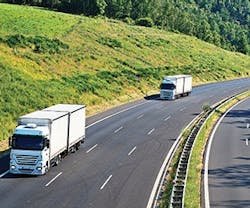How Far Did Your Toilet Paper Travel?
What forest provided your paper towels? How close was that forest to the paper factory where its harvested wood was pulped? What about the factory’s proximity to the distribution center that housed the finished towels?
Untangling the winding road your janitorial products take on their way to your facility can be frustrating at the best of times, but the market is beginning to embrace transportation transparency as consumers demand to know more about products’ chain of custody.
If you’ve been tasked with reducing your company’s carbon footprint, consider product transportation in your plans to directly address the emissions coming out of the trucks and trains delivering your goods.
Define the Scope
Tracking transportation is difficult – not least because there isn’t one single agreed-upon method of measuring transportation impact.
That’s why, before you start measuring the path your products take on the way to your facility, you need to decide how far back in the chain of custody to trace each product. Do you only want to know how your product gets from the manufacturer to your building, or will you include how individual components reach the manufacturer?
To find the answer, figure out what your organization will do when that information is obtained from manufacturers, suggests Thomas Taylor, principal and founder of the sustainability consulting firm Vertegy.
“Are you going to change a vendor from 900 miles away to one 400 miles away, thus cutting down on carbon emissions? If so, why not just track who you buy it from?” says Taylor. “If you’re a global leader and want to show consumers that you’re concerned about everything you do environmentally, you might track it all the way back, insist that your vendors do tracking as well, and include that in a publicly communicated fact sheet.”
Know Where to Look
The data you’ll need to determine transportation impacts varies by material type, explains Joan Monaco, development director of EcoForm, a technical analysis firm focusing on environmental performance. Products that are based on commodity chemicals and virgin plastics (which are petroleum-based) can be difficult to track completely, so focusing on the finished product’s journey between the manufacturer and your facility might be the best option.
However, forestry- and agricultural-based products like toilet paper and hand towels offer a clearer look at the chain of custody. “It’s easier to track where raw materials are grown and where they are processed into final products,” explains Monaco.
“When looking at the transportation impacts of a product, the value lies in the comparison that the available information allows you to make,” Monaco adds. “If an FM is comparing two types of toilet paper that are in all other ways equal, then asking a distributor where the trees are grown or where the recycled fiber is sourced, where the pulp is processed, and where the final product is produced may uncover a difference in overall environmental performance.”
Investigate Key Resources
Also check out the handful of product certifications that can help you on your way. While none of them cover the entire chain of custody, they can help provide clues. Your options include:
Forest Stewardship Council (FSC) certification: FSC requires chain of custody tracking for materials, but “they don’t necessarily translate those into the environmental impacts associated with transportation,” says Monaco.
Environmental Product Declarations (EPDs): Not all declarations list transportation information, so ask vendors for a third-party-reviewed EPD that outlines the product’s entire environmental profile. You can also check into Product Transparency Declarations (PTDs) or Health Product Declarations (HPDs), which have some overlap with EPDs. Whichever source you choose, Monaco recommends collecting three types of information:
- Where the raw material was extracted and processed
- Where the product was manufactured
- How the product traveled from the manufacturer to your facility (such as by barge, truck, or rail) and its route, including any stops at distribution centers
Networking with other local FMs and professional organizations can also uncover valuable insights on vendors or distributors who can provide transparency, Taylor adds.
Investigate local chapters of BOMA or IFMA if you’re not already a member. If your organization maintains a portfolio of buildings with on-site FMs, speak to your counterparts at other locations to determine how they’re choosing products. If you don’t have the results you want after that, consider broadening your search to the rest of the market.
“Don’t be afraid to call in another vendor and say ‘These are the things I’m looking for in a product. Do you have them? So far, I haven’t found anyone who does,’” says Taylor. “Do your research, collect the data you want, and then use your organization’s strength and the insights of your peer group to seek out those vendors.”
Janelle Penny is senior editor of BUILDINGS.
About the Author
Janelle Penny
Editor-in-Chief at BUILDINGS
Janelle Penny has been with BUILDINGS since 2010. She is a two-time FOLIO: Eddie award winner who aims to deliver practical, actionable content for building owners and facilities professionals.

